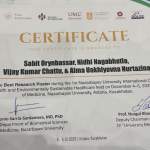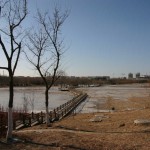Utilising Nature-Based Solutions and Nature-Positive Engineering to Create Resilient States, Societies and Communities
Nature-Based Solutions (NbS) and Nature-Positive Engineering (NPE) are transformative approaches to address pressing environmental challenges while enhancing biodiversity and ecosystem health. These strategies foster resilience in natural systems and promote sustainable development by integrating ecological principles into engineering practices.
On 23 October, Senior Research Fellow Nidhi Nagabhatla is invited to speak at the Indian Institute of Technology Bombay (IIT Bombay), part of the Ashank Desai Centre for Policy Studies, as part of their Policy Talks series.
In her address, she will discuss five key points on how Implementing NbS and NPE faces significant hurdles. The first is institutional inertia, limited awareness among stakeholders, and inadequate incorporation of ecological considerations in engineering spaces. There is a need to overcome these barriers, and there is a need for targeted capacity initiatives and supportive policies that facilitate the adoption of these concepts.
Second, why impact measurement is crucial for demonstrating the benefits of NbS and NPE. Current practices involve establishing baselines through comprehensive mapping and monitoring of ecosystem parameters. Key performance indicators should include metrics related to biodiversity, habitat quality, and overall ecosystem services to validate positive outcomes.
Third is value creation and steering a paradigm shift towards recognizing nature as an asset, which is essential for successfully implementing NbS and NPE. This involves articulating the shared benefits between natural ecosystems and local communities and enhancing stakeholder engagement. Where fitting adopting a value chain approach can elucidate the economic advantages derived from healthy ecosystems, fostering more significant investment in these solutions.
Fourth, meaningful stakeholder engagement and securing buy-in from diverse stakeholder groups is critical for effectively implementing these approaches, wherein engaging local communities in co-design processes ensures that projects reflect their needs and insights, thereby reducing resistance and increasing project success rates. Failing to involve key community stakeholders can lead to project setbacks.
And fifth, interoperability, the opportunities for future implementation; the current landscape presents substantial opportunities for scaling up NbS and NPE practices, particularly in sectors such as coastal protection, offshore renewable energy, and sustainable port operations. Identifying leverage points—such as establishing standards, enhancing engineer training, and creating policy frameworks—can facilitate broader adoption of nature-positive approaches.
In summary, the twin approach offers promising pathways to sustainable development by aligning engineering practices with ecological integrity. By fostering collaboration among stakeholders and emphasizing the intrinsic value of nature in decision-making processes, society can advance toward a resilient future that prioritizes both human well-being and environmental health. Embracing these innovative approaches is not just beneficial but essential for addressing the multifaceted environmental challenges and impacts of climate change.




